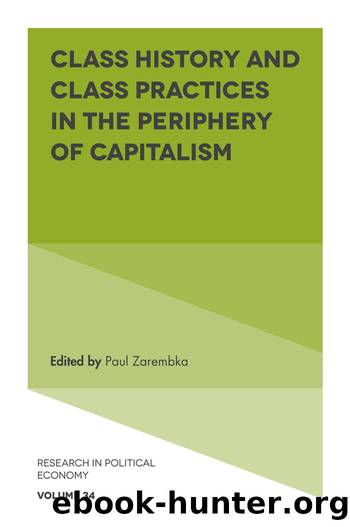Class History and Class Practices in the Periphery of Capitalism by Paul Zarembka

Author:Paul Zarembka [Zarembka, Paul]
Language: eng
Format: epub
Tags: Nonfiction, Social & Cultural Studies, Political Science, Politics, Economic Conditions, Business & Finance
ISBN: 9781789735932
Amazon: B07R2MS9JY
Barnesnoble: B07R2MS9JY
Goodreads: 52922059
Publisher: Emerald Publishing Limited
Published: 2019-09-03T04:00:00+00:00
The Development of Capitalism in Argentina
After the Independence and Civil Wars which lasted almost three-quarters of the nineteenth century, Argentina emerged as a politically organized state ruled by a dominant class formed by merchants and landlords from the central Pampa and sugar planters from the Northwest. The war against Paraguay and the military conquest of the indigenous territories of Patagonia and Chaco established the complete boundaries of the country. The destiny of the land and its inhabitants was established according to the requirements of the new place Argentina was occupying in the world market (âthe breadbasket of the worldâ), shaped by the new phase of capitalist development, namely imperialism. Argentina became a classic example of a âdependent country,â formally independent but clearly subordinated to financial and political British power, and where French and German capitals also had a place.
The new link between Argentina and the capitalist world market boosted the development of capitalism, producing a change in the dominant social type of exploitation from commercial capitalism to industrial capitalism, based on wage relations. Argentina provided Europe with wool, meat, and leather; and by the end of the century, also wheat, corn, and other cereals. Along with production for the world market there was a development of railways, ports, and cities and a population that required the expansion of the production of consumer goods, though a significant portion of these were imported.
The development of capitalism required the existence of a population deprived of their material conditions of existence, forced to sell their labor power. As the native labor power was insufficient, all governments, from 1875 through 1930, fostered immigration from Europe. Thus, millions of immigrants arrived, in particular from Spain and Italy. In fact, around 1914, the city of Buenos Aires had as many foreign as Argentine inhabitants.4 These immigrants joined those who in Argentina had been deprived of their material conditions of existence when the previous modes of production articulated by merchant capital were subordinated or destroyed. Both the increase of the population and its concentration in the eastern cities and ports produced a new division of labor together with a shift from artisan to industrial consumer goods production.
By the end of the nineteenth century, capitalist relations had reached an important degree of development. Along with the growth of a mass of non-proletarian workers (artisans, small merchants, and peasants), a proletariat (both rural workers and those in industry and railways) became the most numerous social group in Argentine society. In 1895 about 54% of the population (900,000 people) was involved in wage relations as proletarians (Ortiz, 1964a). In 1914 they were 1,780,000 (55.1%; Ortiz, 1964b).5 The main goods for export were produced by capitalist tenants.
The First World War favoured a feeble expansion of industries.
From 1870 on for a hundred years,6 capitalism developed in breadth, through territorial expansion, where non-capitalist relations prevailed, rather than by intensive expansion, in depth. Consequently, there was an attraction movement of population coming first from Europe, and afterward from the inland provinces, that migrated to Buenos Aires, Rosario and the coast.
Download
This site does not store any files on its server. We only index and link to content provided by other sites. Please contact the content providers to delete copyright contents if any and email us, we'll remove relevant links or contents immediately.
Zero to IPO: Over $1 Trillion of Actionable Advice from the World's Most Successful Entrepreneurs by Frederic Kerrest(4064)
Machine Learning at Scale with H2O by Gregory Keys | David Whiting(3640)
Harry Potter and the Goblet Of Fire by J.K. Rowling(3612)
Never by Ken Follett(3534)
Ogilvy on Advertising by David Ogilvy(3339)
Shadow of Night by Deborah Harkness(3177)
The Man Who Died Twice by Richard Osman(2811)
Book of Life by Deborah Harkness(2721)
My Brilliant Friend by Elena Ferrante(2704)
How Proust Can Change Your Life by Alain De Botton(2616)
0041152001443424520 .pdf by Unknown(2599)
Will by Will Smith(2581)
The Tipping Point by Malcolm Gladwell(2562)
How to Pay Zero Taxes, 2018 by Jeff A. Schnepper(2503)
Purple Hibiscus by Chimamanda Ngozi Adichie(2493)
Hooked: A Dark, Contemporary Romance (Never After Series) by Emily McIntire(2423)
Rationality by Steven Pinker(2150)
Borders by unknow(2119)
Daughter of Smoke and Bone by Laini Taylor(2083)
